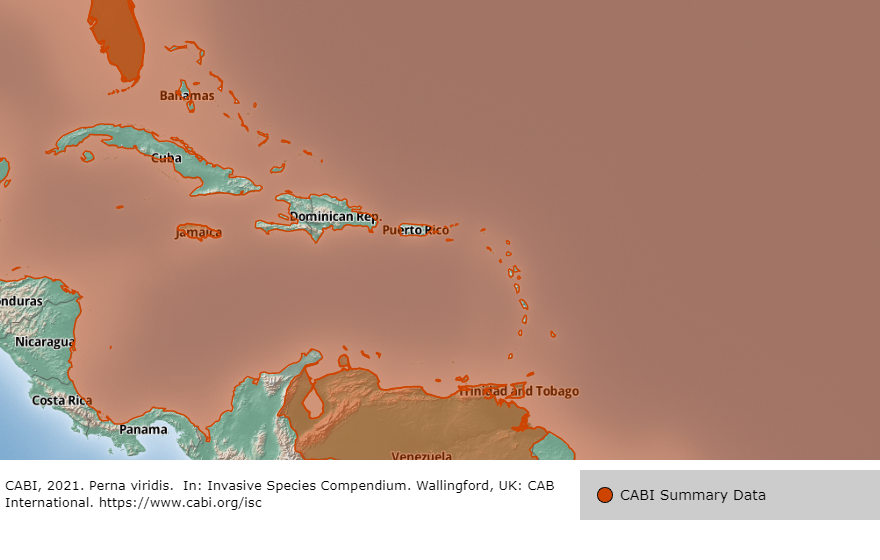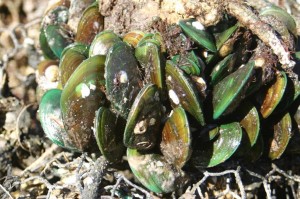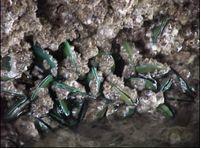The Asian green mussel (Perna viridis), also known as the Philippine green mussel, is a bivalve belonging to the family Mytilidae. The mussel is economically important in several countries where it is harvested for food; however it is known to harbor toxins, which are hazardous to human health and cause damage to submerged structures such as drainage pipes. It is native in the Asia-Pacific region and was introduced in the waters of Australia, the Caribbean, Japan, North America, and South America as invasive species via boat hulls and water ballasts.
SPECIES DESCRIPTION
Scientific name: Perna viridis
Common name: Asian green mussel, Philippine green mussel
Taxonomic position:
Kingdom: Animalia
Phylum: Mollusca
Class: Bivalvia
Subclass: Pteriomorphia
Order: Mytiloida
Family: Mytilidae
Genus: Perna
Species: P. viridis
Native range: Asia-Pacific region
Distribution: Australia, the Caribbean, Japan, North America, and South America
Distribution Map (CABI ISC):

Figure 1: Perna viridis showing the downward-pointing beak and the dark green color that becomes brownish towards the umbo
Perna viridis generally ranges from 80 to 100 millimeters in length and may occasionally reach 165 mm. Its shell ends in a downward-pointing beak. The smooth periostracum (outer shell) is dark green, becoming increasingly brownish towards its point of attachment (umbo), where it is lighter. Younger mussels are bright green and become darker as it ages. The shell’s interior has a pale-blue sheen. The mussel has a large mobile foot which it uses to climb vertically should it be covered by sediments. It also produces byssus to help it attach to its substrate.
ECOLOGY
Habitat and distribution
Perna viridis typically occurs at depths of less than 10 metres and inhabits intertidal, subtidal and estuarine environments and is often found in densities as high as 35,000 individuals per square meter in any submerged marine object. While the mussels usually attach to hard substrata they are capable of relocating and can colonize manmade habitats such as bridges, pier pilings, sea walls, boys, boats, etc. In countries such as Jamaica and Trinidad they can also be found attached to red mangrove roots.
The mussels usually live in waters that are 10-35ºC with a wide-ranging salinity of about 18-33 ppt. P. viridis grows fastest at 2 meters below the surface, in high salinity and high concentration of phytoplankton although it can tolerate a range of salinity and turbid water.
Life History
Figure2: A group of Perna viridis attached on a rocky substrate
The Green Mussel has separate sexes and fertilizes externally, however there are a very few functional hermaphrodites (<0.1%). The mussel’s sexual development is affected by temperature. Spawning generally occurs twice a year between early spring and late autumn; however, the mussels found in the Asia are known to spawn all year round. The zygote transforms into a larva 7-8 hours after fertilization. The larvae usually stay in the water column for 10-12 days before undergoing metamorphosis into a juvenile and settling onto a surface. However the larvae have the ability to remain free swimming organisms for up to 150 days – this increases the potential of the mussel to remain viable in the ballast water of ships and be easily geographical distributed.
The juveniles become sexually mature after 2-3 months and are approximately 15-30 mm in length. Growth is influenced by the availability of food, temperature, salinity and water movement. The adult can live to up 2-3 years. Due to its fast growth, it can out compete other fouling organisms and cause changes in marine community structure and ecological trophic relationships.
Importance to humans
P. viridis is harvested as a food source due to its fast growth. However, it can harbor the deadly toxin Saxitoxin, which is produced by the dinoflagellates that it feeds upon. Its abiltity to bioaccumulate toxins enables it to be used as a biomonitor to indicate pollution caused by heavy metals, organochlorides and petroleum products. Mussels that are in contaminated areas have labile lysosomal membranes due to metal-induced stress.
IMPACT
As an invasive species, we can note that the mussel is notorious for clogging and corroding water pipes used by industrial complexes; fouling marine equipment and threating the sustainability of the shellfish fishery. It also has the potential to displace native mussels by introducing harmful parasites and diseases.


